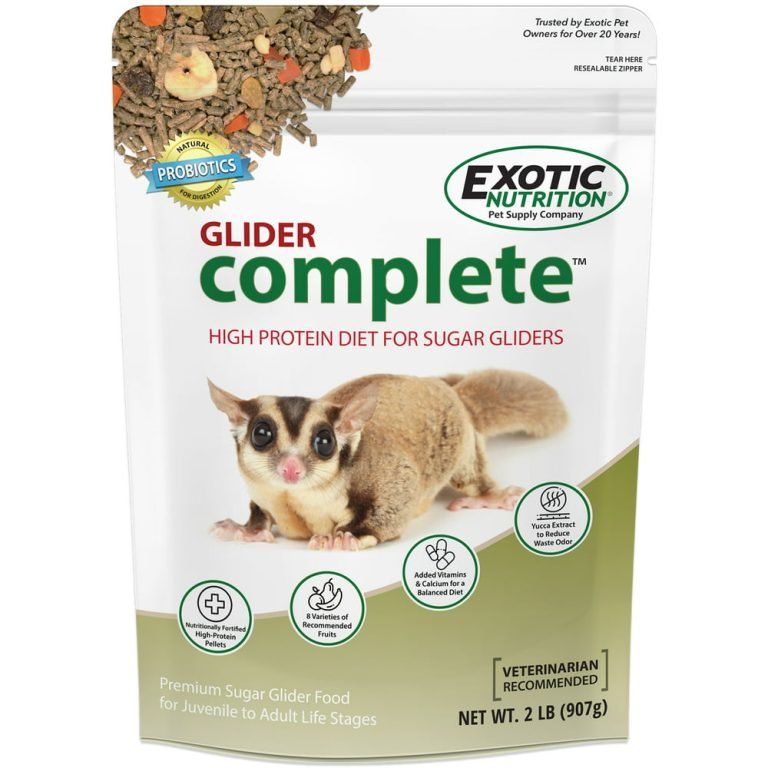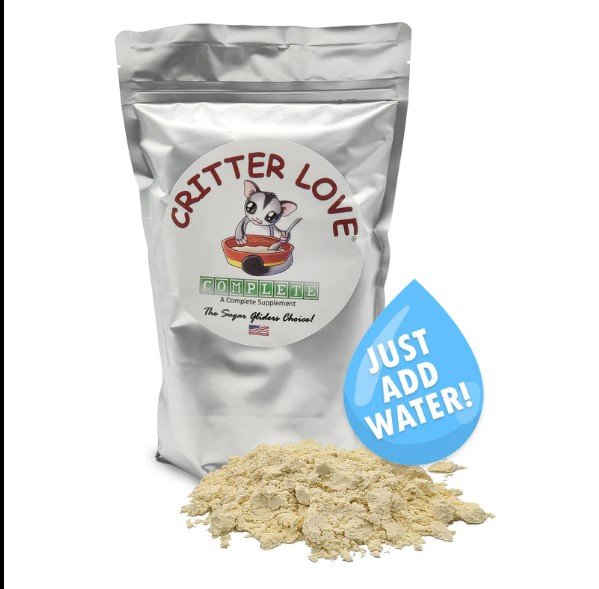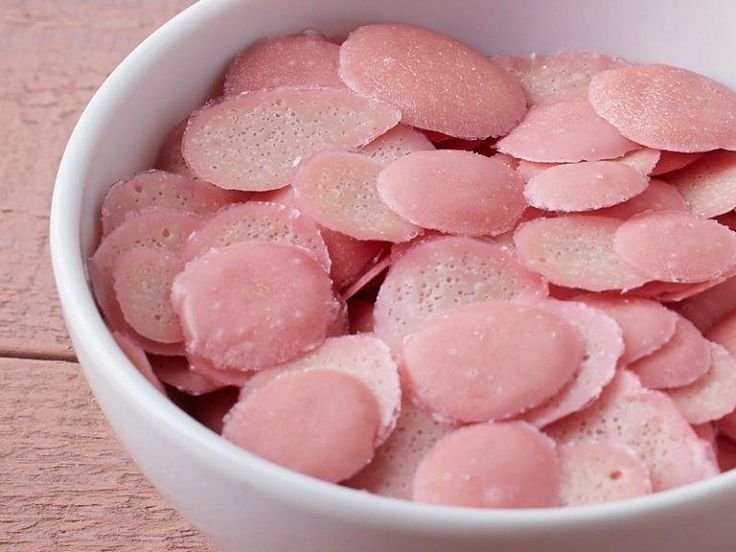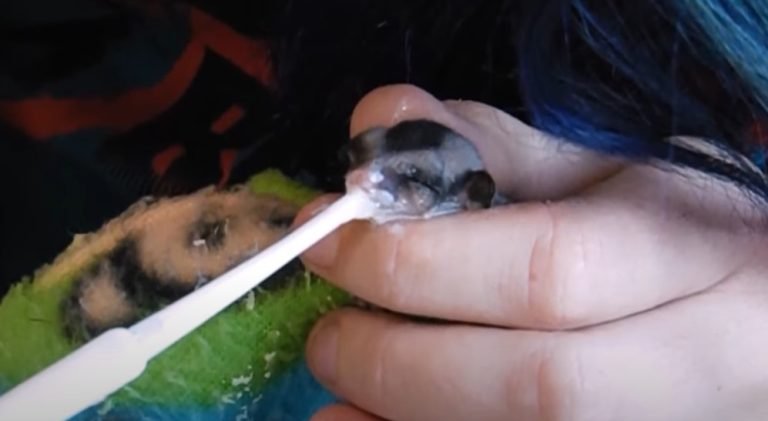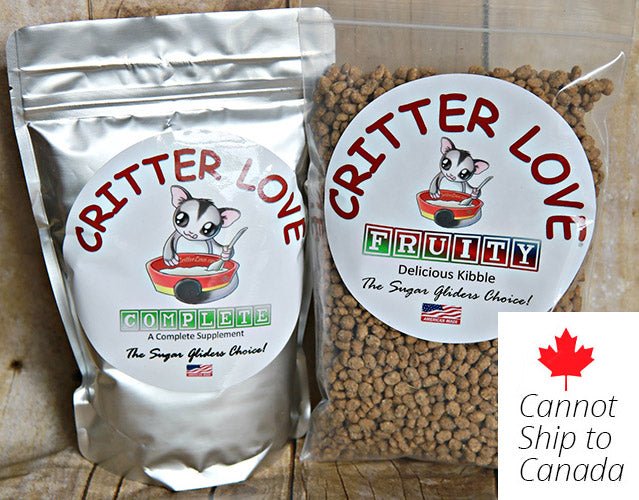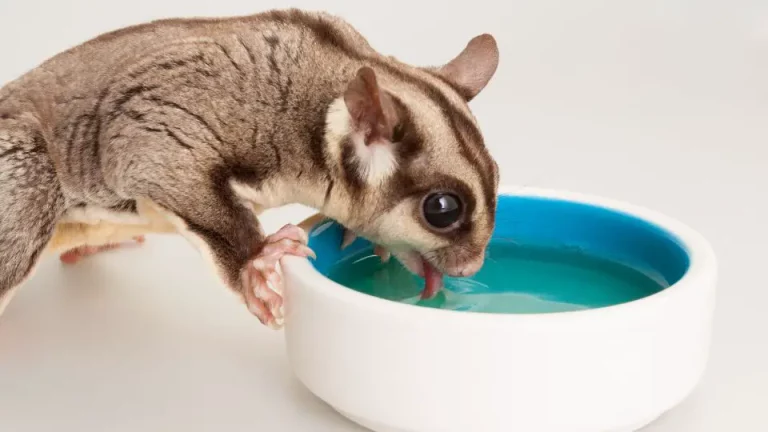What can a sugar glider eat?
The sugar glider is a marsupial, which means that it is born with its eyes open and is able to feed itself from an early age. A sugar glider will eat any type of fruit or nectar found in the wild. They will also eat other insects and even spiders.
Are you the proud owner of a sugar glider? These cute and cuddly creatures require special care, including a specific diet to keep them healthy and happy. In this guide, we’ll explore the ins and outs of feeding your sugar glider, including what can a sugar glider eat?, what to avoid, and tips for creating a balanced diet.
Importance of diet for sugar gliders
A sugar glider’s diet is incredibly important for their health and well-being. As omnivores, sugar gliders require a balanced diet of both animal protein and plant-based foods to thrive.
In the wild, sugar gliders consume a variety of foods such as insects, nectar, tree sap, and fruits. As pets, it is important to mimic their natural diet as closely as possible to ensure they receive all the necessary nutrients.
A healthy sugar glider diet should consist of high-quality pellet food, fresh fruits and vegetables, and a source of protein such as cooked eggs or mealworms. It is also important to offer them fresh water at all times.
Sugary or high-fat foods should be avoided as they can lead to obesity and other health issues. Additionally, certain foods such as avocado, chocolate, and caffeine can be toxic to sugar gliders and should never be fed to them.
It is important to consult with a veterinarian who specializes in exotic pets to ensure your sugar glider’s diet is balanced and meets their nutritional needs. By providing your sugar glider with a nutritious diet, you can help ensure they live a long and healthy life.
Natural diet of sugar gliders in the wild

In the wild, sugar gliders have a varied diet that consists of both plant-based and animal-based foods. As omnivores, they consume a wide range of items.
Sugar gliders primarily feed on insects such as beetles, moths, and spiders. They are also known to eat small vertebrates like lizards and birds.
Sugar gliders also feed on tree sap and nectar. They are particularly fond of the sweet sap produced by eucalyptus and acacia trees.
Fruits also make up a part of a sugar glider’s diet in the wild. They feed on a variety of fruits such as figs, apples, and grapes.
Generally, a sugar glider’s natural diet in the wild is diverse and includes a range of different foods. This highlights the importance of providing a varied and balanced diet to pet sugar gliders to ensure they receive all the necessary nutrients for their health and well-being.
Natural diet of sugar gliders as a Pet
As pets, sugar gliders require a diet that closely mimics their natural diet in the wild to ensure they receive all the necessary nutrients.
A balanced sugar glider diet typically consists of a high-quality pellet food as a base, supplemented with fresh fruits and vegetables, and a source of animal protein such as cooked eggs or mealworms.
Fruits that are safe for sugar gliders to consume include apples, bananas, blueberries, grapes, and melons, among others. Vegetables such as sweet potatoes, carrots, and green beans are also good options. It is important to avoid feeding them fruits and vegetables that are high in sugar, such as grapes and bananas, in excess as it can lead to obesity.
In terms of protein sources, cooked eggs, mealworms, crickets, and other insects are safe and nutritious options for sugar gliders. It is important to ensure that any insects fed to sugar gliders are gut-loaded (fed a nutritious diet) prior to being offered to them.
It is essential to avoid feeding sugar gliders foods that are toxic to them, such as chocolate, caffeine, and avocado. These foods can cause serious health problems or even death.
Providing a balanced and varied diet is crucial for the health and well-being of pet sugar gliders. It is recommended to consult with a veterinarian who specializes in exotic pets for guidance on a suitable diet plan for your sugar glider.
Understanding the nutritional needs of sugar gliders
Understanding the nutritional needs of sugar gliders is crucial for their health and well-being as pets. As omnivores, they require a balanced diet that consists of both plant-based and animal-based foods.
Protein is essential in a sugar glider’s diet, and it can be obtained from a variety of sources such as cooked eggs, mealworms, and crickets. In the wild, sugar gliders primarily feed on insects as a source of protein.
Fruits and vegetables also play an important role in a sugar glider’s diet. They provide essential vitamins and minerals that help support the immune system and overall health. Safe fruits for sugar gliders to consume include apples, bananas, grapes, and melons. Vegetables such as sweet potatoes, carrots, and green beans are also good options.
It is important to offer high-quality pellet food as the base of a sugar glider’s diet to ensure they receive all the necessary nutrients. However, it is not recommended to rely solely on pellet food, as it can be lacking in certain nutrients.
Sugar gliders also require calcium and phosphorus in their diet to maintain healthy bones and teeth. Calcium can be found in dark leafy greens such as kale and collard greens, while phosphorus can be obtained from animal-based foods such as eggs and insects.
It is essential to avoid feeding sugar gliders foods that are toxic to them, such as chocolate, caffeine, and avocado. These foods can cause serious health problems or even death.
Consulting with a veterinarian who specializes in exotic pets is recommended for guidance on a suitable diet plan for your sugar glider. By providing a balanced and varied diet, you can help ensure your sugar glider lives a long and healthy life.
Commercially available food options
There are several commercially available food options for sugar gliders that provide a balanced diet. These options include pellet food, freeze-dried insects, and freeze-dried fruits.
Pellet food is a popular option for sugar gliders, as it provides a balanced base for their diet. Some pellet foods are specifically formulated for sugar gliders and contain added vitamins and minerals.
Freeze-dried insects, such as mealworms and crickets, are a convenient way to provide protein to sugar gliders. They are also a good option for those who are squeamish about handling live insects.
Freeze-dried fruits, such as apples, bananas, and mangoes, are a safe and nutritious treat for sugar gliders. They provide essential vitamins and minerals while satisfying their sweet tooth.
When choosing commercially available food options for sugar gliders, it is important to choose high-quality products and avoid foods with added sugars or artificial preservatives. It is also important to supplement their diet with fresh fruits and vegetables to ensure they receive a varied and balanced diet. Consulting with a veterinarian who specializes in exotic pets is recommended for guidance on choosing the best commercially available food options for your sugar glider.
Fruits and Vegetables for Sugar Gliders

Safe and nutritious fruits for sugar gliders
Fruits are an important part of a sugar glider’s diet, providing essential vitamins and minerals. However, not all fruits are safe for them to consume. Here are some safe and nutritious fruits for sugar gliders:
- Apples
- Bananas
- Blueberries
- Cantaloupe
- Grapes
- Kiwi
- Mangoes
- Papayas
- Pineapples
- Strawberries
- Watermelon
It is important to remember that fruits should be given in moderation, as they are high in sugar. Feeding too many fruits to sugar gliders can lead to obesity and other health problems. It is also important to avoid feeding fruits with seeds, such as apples and watermelon, as the seeds can be a choking hazard. Always remove the seeds and cut the fruit into small pieces before offering it to your sugar glider. By providing a balanced and varied diet that includes safe and nutritious fruits, you can help ensure your sugar glider stays healthy and happy.
Here is a chart of safe fruits for sugar gliders:
| Fruit | Safe for Sugar Gliders? |
| Apples | Yes |
| Bananas | Yes |
| Blueberries | Yes |
| Cantaloupe | Yes |
| Grapes | Yes |
| Kiwi | Yes |
| Mangoes | Yes |
| Papayas | Yes |
| Pineapples | Yes |
| Strawberries | Yes |
| Watermelon | Yes |
Safe and nutritious vegetables for sugar gliders
Vegetables are an important part of a sugar glider’s diet, providing essential vitamins and minerals. Here are some safe and nutritious vegetables for sugar gliders:
- Carrots
- Sweet potatoes
- Squash
- Green beans
- Peas
- Corn
- Broccoli
- Kale
- Spinach
- Collard greens
It is important to remember that vegetables should be given in moderation, as they are low in fat and protein. Feeding too many vegetables to sugar gliders can lead to weight loss and other health problems. It is also important to avoid feeding vegetables with high levels of oxalates, such as spinach and kale, as they can interfere with calcium absorption. Always wash the vegetables thoroughly and cut them into small pieces before offering them to your sugar glider. By providing a balanced and varied diet that includes safe and nutritious vegetables, you can help ensure your sugar glider stays healthy and happy.
Here is a chart of safe vegetables for sugar gliders:
| Fruit | Safe for Sugar Gliders? |
| Apples | Yes |
| Bananas | Yes |
| Blueberries | Yes |
| Cantaloupe | Yes |
| Grapes | Yes |
| Kiwi | Yes |
| Mangoes | Yes |
| Papayas | Yes |
| Pineapples | Yes |
| Strawberries | Yes |
| Watermelon | Yes |
Protein Sources for Sugar Gliders
Protein is an essential part of a sugar glider’s diet and can be provided through a variety of sources. Insects, such as crickets, mealworms, and waxworms, are a popular protein source for sugar gliders. Other options include cooked chicken, turkey, and scrambled eggs. It is important to ensure that any protein source offered to sugar gliders is low in fat and free from any seasoning or additives.
Importance of protein in sugar gliders’ diet
Protein is an essential component of a sugar glider’s diet, as it plays a vital role in the growth, development, and repair of tissues in their bodies. Without adequate protein intake, sugar gliders may experience stunted growth, weakened immune systems, and other health issues.
In the wild, sugar gliders primarily consume insects, which provide them with a rich source of protein. As pets, sugar gliders can be fed a diet that includes a variety of protein sources, such as crickets, mealworms, waxworms, cooked chicken, turkey, and scrambled eggs. It is important to ensure that any protein source offered to sugar gliders is low in fat and free from any seasoning or additives.
It is also important to note that while protein is necessary for sugar gliders’ health, too much protein can be harmful. Overfeeding protein can lead to obesity, kidney problems, and other health issues. A balanced diet that includes the appropriate amount of protein is crucial for maintaining the health and well-being of sugar gliders.
Safe and nutritious protein sources for sugar gliders
Protein is an essential part of a sugar glider’s diet, and there are a variety of safe and nutritious protein sources that you can offer your pet. Insects, such as crickets, mealworms, and waxworms, are a popular choice, as well as cooked chicken, turkey, and scrambled eggs.
It is important to ensure that any protein source offered to sugar gliders is low in fat and free from any seasoning or additives. Feeding too much protein can lead to obesity, kidney problems, and other health issues.
Here is a chart of safe and nutritious protein sources for sugar gliders:
| Protein Source | Safe for Sugar Gliders? |
| Crickets | Yes |
| Mealworms | Yes |
| Waxworms | Yes |
| Chicken | Yes |
| Turkey | Yes |
| Scrambled eggs | Yes |
| Boiled egg | Yes |
| Tofu | Yes, in moderation |
| Low-fat cottage cheese | Yes, in moderation |
You can keep your sugar glider healthy and happy by providing a balanced, varied, and nutritious diet.
How Do Sugar Gliders Find Food
In the wild, sugar gliders use their keen sense of smell to locate food sources. They primarily feed on insects, nectar, and tree sap, which they find by searching through trees and using their sense of smell to detect food sources.
Sugar gliders are also known to be opportunistic feeders and will eat whatever food sources are available to them. They have a specialized diet that includes a variety of nutrients, including protein, fat, and carbohydrates.
As pets, sugar gliders should be provided with a balanced and varied diet that includes a mix of fruits, vegetables, and protein sources. Commercially available sugar glider food mixes can also be a convenient option to ensure that your pet is receiving all the necessary nutrients.
A sugar glider’s diet should be tailored to meet their specific dietary needs. It is important to provide your sugar glider with a variety of nutritious and safe foods.
What Should Sugar Gliders Avoid?
While sugar gliders have a diverse diet, there are certain foods that they should avoid. It is important to avoid offering foods that are high in sugar, fat, or salt, as well as foods that are toxic to sugar gliders.
Here is a chart of foods to avoid feeding your sugar glider:
| Food to Avoid | Reason |
| Chocolate | Toxic to sugar gliders |
| Avocado | Toxic to sugar gliders |
| Garlic | Toxic to sugar gliders |
| Onions | Toxic to sugar gliders |
| Grapes | High in sugar and can cause kidney problems |
| Dried fruits | High in sugar and can cause digestive problems |
| Seeds | High in fat and can cause obesity |
| Processed foods | High in salt and other additives, unhealthy for pets |
By avoiding these foods and offering a balanced diet that meets their nutritional needs, you can help ensure that your sugar glider stays healthy and happy. If you are unsure about the safety of a certain food, consult with a veterinarian who is knowledgeable about sugar gliders.
Final Thoughts
Sugar gliders have a diverse diet that includes a variety of fruits, vegetables, and protein sources. As pets, it is important to offer a balanced and varied diet that meets their nutritional needs.
When selecting foods to feed your sugar glider, it is important to avoid foods that are high in sugar, fat, or salt, as well as foods that are toxic to sugar gliders.
By providing a balanced diet that includes a mix of safe and nutritious foods, you can help ensure that your sugar glider stays healthy and happy. If you are unsure about the safety of a certain food, consult with a veterinarian who is knowledgeable about sugar gliders. With proper care and attention, sugar gliders can make wonderful pets.
FAQs
1.What is the best diet for sugar gliders?
The best diet for sugar gliders consists of a variety of safe and nutritious fruits, vegetables, and protein sources, with a focus on a balanced and varied diet that meets their nutritional needs.
2.How often should I feed my sugar gliders?
Sugar gliders should be fed twice a day, once in the morning and once in the evening, with a small snack before bedtime. It is important to provide fresh water and remove any uneaten food regularly to prevent spoilage.
3.Can sugar gliders eat human food?
While sugar gliders can eat some human food, it is important to only offer safe and nutritious options in moderation. It is best to focus on a balanced diet that meets their specific nutritional needs.
4.What are the most nutritious treats for sugar gliders?
Safe and nutritious treats for sugar gliders include mealworms, waxworms, boiled eggs, and small amounts of fresh fruits such as blueberries or papaya. It is important to offer treats in moderation and as part of a balanced diet.
5.Can sugar gliders eat mealworms?
Yes, mealworms are a safe and nutritious protein source for sugar gliders and can be offered as a treat or part of their regular diet. It is important to purchase mealworms from a reputable source and to offer them in moderation.


